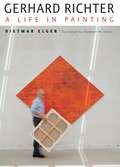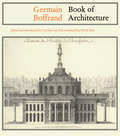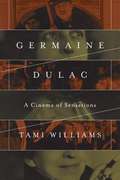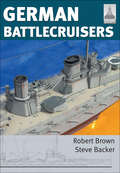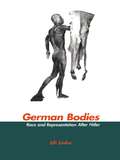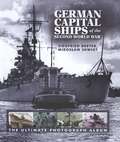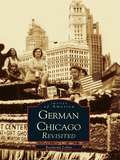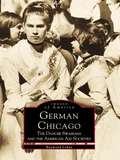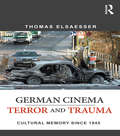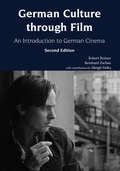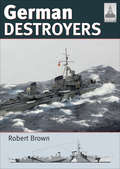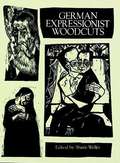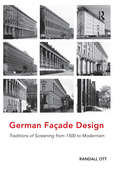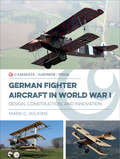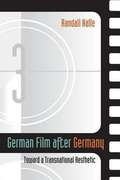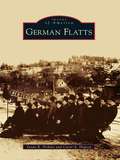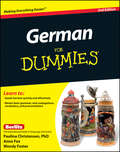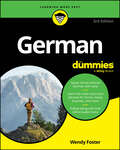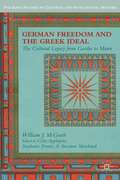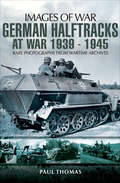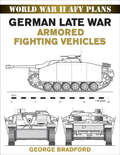- Table View
- List View
Gerhard Richter: A Life In Painting
by Dietmar Elger Elizabeth M. SolaroThis fascinating book offers unprecedented insight into artist Gerhard Richter's life and work. From his childhood in Nazi Germany to his time in the West during the turbulent 1960s and '70s, this work presents a complete portrait of the often-reclusive Richter.
Germain Boffrand: Book of Architecture Containing the General Principles of the Art and the Plans, Elevations and Sections of some of the Edifices Built in France and in Foreign Countries
by Caroline van EckThis title was first published in 2003. Germain Boffrand was one of the great French architects of the early eighteenth century. His work encompassed not only the design of town and country houses for the wealthy but also mines, bridges and hospitals. His Livre d’Architecture is one of the most original books on architecture ever written in France. Taking the Art of Poetry by the Latin poet Horace as its starting point, it developed an aesthetic of architecture focused on character, style and the emotional impact of a building that influenced Blondel, Le Camus de Mezieres and Soane, and is still central to contemporary debate about the nature and meaning of architecture. Translated for the first time by David Britt, Boffrand’s text is here accompanied by an extensive introduction and notes by Caroline van Eck who situates Boffrand within the main issues of eighteenth-century architectural aesthetics. Beautifully illustrated, including all the pictures chosen by Boffrand for his original publication, this book is an invaluable tool for teaching the history of architectural theory and an essential work for any architectural library. Germain Boffrand is published with the assistance of the Getty Foundation.
Germaine Dulac: A Cinema of Sensations
by Tami WilliamsBest known for directing the Impressionist classic The Smiling Madame Beudet and the first Surrealist film The Seashell and the Clergyman, Germaine Dulac, feminist and pioneer of 1920s French avant-garde cinema, made close to thirty fiction films as well as numerous documentaries and newsreels. Through her filmmaking, writing, and cine-club activism, Dulac's passionate defense of the cinema as a lyrical art and social practice had a major influence on twentieth century film history and theory. In Germaine Dulac: A Cinema of Sensations, Tami Williams makes unprecedented use of the filmmaker's personal papers, production files, and archival film prints to produce the first full-length historical study and critical biography of Dulac. Williams's analysis explores the artistic and sociopolitical currents that shaped Dulac's approach to cinema while interrogating the ground breaking techniques and strategies she used to critique conservative notions of gender and sexuality. Moving beyond the director's work of the 1920s, Williams examines Dulac's largely ignored 1930s documentaries and newsreels establishing clear links with the more experimental impressionist and abstract works of her early period. This vivid portrait will be of interest to general readers, as well as to scholars of cinema and visual culture, performance, French history, women's studies, queer cinema, in addition to studies of narrative avant-garde, experimental, and documentary film history and theory.
German Architecture for a Mass Audience
by Kathleen James-ChakrabortyThis book vividly illustrates the ways in which buildings designed by many of Germany's most celebrated twentieth century architects were embedded in widely held beliefs about the power of architecture to influence society. German Architecture for a Mass Audience also demonstrates the way in which these modernist ideas have been challenged and transformed, most recently in the rebuilding of central Berlin.
German Battlecruisers (ShipCraft #22)
by Robert Brown Steve BackerThe 'ShipCraft' series provides in-depth information about building and modifying model kits of famous warship types. Lavishly illustrated, each book takes the modeller through a brief history of the subject class, highlighting differences between sisterships and changes in their appearance over their careers. This includes paint schemes and camouflage, featuring colour profiles and highly-detailed line drawings and scale plans. The modelling section reviews the strengths and weaknesses of available kits, lists commercial accessory sets for super-detailing of the ships, and provides hints on modifying and improving the basic kit. This is followed by an extensive photographic survey of selected high-quality models in a variety of scales, and the book concludes with a section on research references—books, monographs, large-scale plans and relevant websites.This volume is devoted to the famous ships of Admiral Hipper's First Scouting Group. Slower but more robust than their British equivalents, German battlecruisers enjoyed a reputation for absorbing punishment, and although Lutzow was sunk at Jutland, Seydlitz and the rest of the Scouting Group survived heavy damage. This book concentrates on the seven completed ships but coverage extends to the 'proto-battlecruiser' Blucher and the ships building or designed by the end of the war.
German Bodies: Race and Representation After Hitler
by Uli LinkeFirst published in 1999. Routledge is an imprint of Taylor & Francis, an informa company.
German Capital Ships of the Second World War: The Ultimate Photograph Album
by Miroslaw Skwiot Siegfried Breyer&“Outstanding . . . covers the major units starting with the Deutschland Class, through the Scharnhorst and Gneisenau, to the Bismarck and Tirpitz.&” —WW2 Cruisers The Kriegsmarine&’s capital ships—Deutschland, Admiral Scheer, Graf Spee, Scharnhorst, Gneisenau, Bismarck, and Tirpitz—continue to generate intense interest among warship enthusiasts, despite the fact that no new source of information has been unearthed in decades. What has come to light, however, is a growing number of photographs, many from private albums and some that lay forgotten in obscure archives. These include many close-ups and onboard shots of great value to modelmakers, as well as rare action photos taken during wartime operations. This book is a careful selection of the best of these, but on a grand scale, with around one hundred images devoted to each ship, allowing in-depth coverage of its whole career, from launching and fitting out to whatever fate the war had waiting for it. For sake of completeness, there are even sections reproducing the various design studies that led to each class, while an appendix covers the uncompleted Graf Zeppelin, Germany&’s only attempt to build an aircraft carrier, the vessel which clearly displaced the battleship as the capital ship of the world&’s navies during the war. Essays on technical backgrounds and design origins by the well-known expert Siegfried Breyer and explanatory captions by Miroslaw Skwiot draw out the full significance of this magnificent collection of photos. &“Highly recommended for those who wish to admire seven of the most magnificent warships built anywhere in the twentieth century. We will certainly never see their like again.&” —Journal of the Australian Naval Institute
German Chicago: Revisited (Images of America)
by Raymond LohneGerman Chicago Revisited follows the photographic study which began in German Chicago: The Danube Swabians and the American Aid Societies. With this latest title in the Images of America series, historian and photographer Raymond Lohne crafts another volume about a group of American citizens who preserve their rich heritage with unwavering effort.This book will give readers a glimpse into the life of a close-knit and highly active community, revealing groups like the Kerneir Pleasure Club, the American Aid Society, and the Society of the Danube Swabians. The German musical life of the city is featured, as is the Karneval season and other year-round festivities and celebrations of the Deutsch-Americans of Chicago and its suburbs.
German Chicago: The Danube Swabians and the American Aid Societies
by Raymond LohneIn German Chicago: The Danube Swabians and the American Aid Societies, historian Raymond Lohne presents the Germans who came to be called the Donauschwaben and their American counterparts. This amazing photographic collection of over 200 historic images has been gathered through the efforts of the author and survivors of the Expulsion, as well as numerous German-American societies and individuals throughout the nation.
German Cinema - Terror and Trauma: Cultural Memory Since 1945
by Thomas ElsaesserIn German Cinema – Terror and Trauma Since 1945, Thomas Elsaesser reevaluates the meaning of the Holocaust for postwar German films and culture, while offering a reconsideration of trauma theory today. Elsaesser argues that Germany's attempts at "mastering the past" can be seen as both a failure and an achievement, making it appropriate to speak of an ongoing 'guilt management' that includes not only Germany, but Europe as a whole. In a series of case studies, which consider the work of Konrad Wolf, Alexander Kluge, Rainer Werner Fassbinder, Herbert Achterbusch and Harun Farocki, as well as films made in the new century, Elsaesser tracks the different ways the Holocaust is present in German cinema from the 1950s onwards, even when it is absent, or referenced in oblique and hyperbolic ways. Its most emphatically "absent presence" might turn out to be the compulsive afterlife of the Red Army Faction, whose acts of terror in the 1970s were a response to—as well as a reminder of—Nazism’s hold on the national imaginary. Since the end of the Cold War and 9/11, the terms of the debate around terror and trauma have shifted also in Germany, where generational memory now distributes the roles of historical agency and accountability differently. Against the background of universalized victimhood, a cinema of commemoration has, if anything, confirmed the violence that the past continues to exert on the present, in the form of missed encounters, retroactive incidents, unintended slippages and uncanny parallels, which Elsaesser—reviving the full meaning of Freud’s Fehlleistung—calls the parapractic performativity of cultural memory.
German Combat Equipments 1939-45
by Gordon Rottman Ronald VolstadThe field equipment of the German Army in World War II was closely related to that used throughout World War I and earlier, yet it was of relatively light weight, ruggedly constructed, well designed, functional, and generally of a high quality, though this deteriorated in the later war years. A high degree of design standardisation was maintained in most categories of equipment, though materials and their colours often varied widely. There were also many different specialisations for the various arms of service as well as theatres of combat, such as the Afrikakorps in the Western Desert. This title investigates all manner of German combat equipments throughout World War II, from belt buckles to magazine pouches.
German Cultural Studies: An Introduction
by Rob BurnsMajor changes have been taking place in the context of German Studies in both secondary and higher education, with the focus shifting to a broader range of cultural forms. Based on the view that cultures are the products of class, place, gender, and race,German Cultural Studiestakes account of these changes and adopts an interdisciplinary approach in its wide-ranging study of German culture and society since 1871. Emphasizing recent and contemporary developments, the book features chronological sections on Imperial Germany, the Weimar Republic, the Third Reich, the German Democratic Republic, and the Federal Republic. The contributors chart the growth of modernization and the culture industry in Germany, and examine the extent to which culture in any given period functions as an instrument of ideological manipulation or critical enlightenment. Throughout, the emphasis is on the interactions of culture, society and ideology, and the role of culture in both public and private consciousnesses. Copiously illustrated, and with a comprehensive bibliography, the volume will be essential reading for anyone interested in modern and contemporary German society and its culture.
German Culture through Film: An Introduction to German Cinema
by Robert C. Reimer Reinhard Zachau Margit M. SinkaGerman Culture through Film: An Introduction to German Cinema is an English-language text that serves equally well in courses on modern German film, in courses on general film studies, in courses that incorporate film as a way to study culture, and as an engaging resource for scholars, students, and devotees of cinema and film history. In its second edition, German Culture through Film expands on the first edition, providing additional chapters with context for understanding the era in which the featured films were produced. Thirty-three notable German films are arranged in seven chronological chapters, spanning key moments in German film history, from the silent era to the present. Each chapter begins with an introduction that focuses on the history and culture surrounding films of the relevant period. Sections within chapters are each devoted to one particular film, providing film credits, a summary of the story, background information, an evaluation, questions and activities to encourage diverse interpretations, a list of related films, and bibliographical information on the films discussed.
German Destroyers (Shipcraft Ser. #25)
by Robert BrownThis fully illustrated guide to building model ships covers a variety of WWII era German destroyers with info on accessories and kits of various scales. The &‘ShipCraft&’ series provides in-depth information about building and modifying model kits of famous warship types. Lavishly illustrated, each book takes the modeler through a brief history of the subject class, highlighting differences between sister-ships and changes in their appearance over their careers. Paint and camouflage details are shown with color profiles, line drawings, and scale plans. The modeling section reviews the strengths and weaknesses of available kits, lists commercial accessory sets, and provides hints on modifying and improving the basic kit. This is followed by an extensive photographic gallery of high-quality models in a variety of scales. Each volume concludes with a section on research references, including books, monographs, large-scale plans and websites. This volume covers the large and powerful German destroyers of the Second World War era. Always popular as modelling subjects, interest in them has been further increased recently by the release of a number of very fine large-scale kitsThe &‘ShipCraft&’ series provides in-depth information about building and modifying model kits of famous warship types. Lavishly illustrated, each book takes the modeler through a brief history of the subject class, highlighting differences between sister-ships and changes in their appearance over their careers. This includes paint schemes and camouflage, featuring color profiles and highly detailed line drawings and scale plans. The modeling section reviews the strengths and weaknesses of available kits, lists commercial accessory sets for super-detailing of the ships, and provides hints on modifying and improving the basic kit. This is followed by an extensive photographic gallery of selected high-quality models in a variety of scales, and the book concludes with a section on research references – books, monographs, large-scale plans and relevant web sites. This volume covers the large and powerful German destroyers of the Second World War era. Always popular as modeling subjects, interest in them has been further increased recently by the release of a number of very fine large scale kits. With its unparalleled level of visual information – paint schemes, models, line drawings and photographs – this book is simply the best reference for any model maker setting out to build one of these unusual ships.
German Expressionist Woodcuts
by Shane WellerGerman Expressionism was an extraordinarily vivid presence in the art of the early twentieth century, its violent colors and often distorted, stylized forms reflecting not only the rebellious spirit of its participants, but the revolutionary mood of the new century itself. One of the most popular media used by the German Expressionists was the woodcut, important in the history of German art from the time of Albrecht Dürer (1471-1528), and especially suited to Expressionism's bold graphics.This superb collection presents over 100 finely reproduced woodcuts from the work of nearly 30 major artists in the movement who worked in the woodcut medium. Among them are Ernst Barlach, Max Beckmann, Lyonel Feininger, Ernst Ludwig Kirchner, Käthe Kollwitz, Franz Marc, Emil Nolde, Max Pechstein, and many others. Most of the woodcuts reproduced here date from the first three decades of the twentieth century. They are powerful works, ranging in mood from Felix Müller's pensive portrait of Carl Sternheim (1925) to Franz Marc's electric Riding School (1913) and Ernst Barlach's profoundly moving Christ on the Mount of Olives (1920).Readers interested in the art of the woodcut as well as students and enthusiasts of twentieth-century art will find this volume ideal for browsing and study. Individual captions for each selection, notes on each artist, and an informative introduction to the art of the woodcut and the German Expressionist movement add to the book's value as a reference work.
German Façade Design: Traditions of Screening from 1500 to Modernism
by Randall OttGerman architecture prior to the modern period has received less systemic, analytical study than that of Italy, France, and Britain. Scholarly discussion of broad traditions or continuities within Germanic or Central European façade design is even sparser. Baroque era studies of the region mostly devote themselves to isolated architects, monuments, or movements. Modernism's advent decisively changed this: Germanic architecture enjoyed sudden ascendancy. Yet, even so, study specifically of that region's façades still lagged – nothing compares to the dozens of treatments of Le Corbusier's façade systems, for example, and how these juxtapose with French neoclassical or Italian Renaissance methods. Given the paucity of multi-period studies, one can be forgiven for believing Germany's effervescence of radical, modern works seems unprecedented. This book takes up these multiple quandaries. It identifies and documents a previously unrecognized compositional tradition - characterized here as the 'screen façade' – and posits it as a counter-narrative critiquing the essentialist, 'authentic' canon currently dominant in Western architectural history. By crossing evenly over the dividing line between the historical and modern periods, it offers valuable insights on indigenous roots underlying some aspects of Germany's invigorating early twentieth-century architectural developments. The book chronologically examines 400 years of closely related facades, concentrated in Germany but also found in Austria, the Czech Republic, German-speaking Switzerland, and nearby areas of Central Europe. While nearly 75 buildings are mentioned and illustrated, a dozen are given extensive analysis and the book focuses on the works of three architects – Schinkel, Behrens and Mies. Relationships between examples of these three architects' façades far transcend mere homage amongst masters. Glimmers of the system they eventually codify are apparent as early as at Heidelberg Castle in 1559 and Nürnberg's Rathaus in 1622. The book argues that in Germany, northern Gothic affinities for bisection, intense repetition and rote aggregation intersected with southern Classical affinities for symmetry, hierarchy and centrality, thereby spawning a unique hybrid product – the screen. Instead of graphic formality, this study is guided by on-site perceptions, propositional contrasts, means of approach, interpretive conflicts and emotion and it relates the design of these façades to concepts proposed by contemporary philosophers including Novalis, Hegel, Nietzsche, Freud, Adorno, and, most importantly, Gadamer on hermeneutics.
German Façade Design: Traditions of Screening from 1500 to Modernism
by Randall OttGerman architecture prior to the modern period has received less systemic, analytical study than that of Italy, France, and Britain. Scholarly discussion of broad traditions or continuities within Germanic or Central European façade design is even sparser. Baroque era studies of the region mostly devote themselves to isolated architects, monuments, or movements. Modernism's advent decisively changed this: Germanic architecture enjoyed sudden ascendancy. Yet, even so, study specifically of that region's façades still lagged – nothing compares to the dozens of treatments of Le Corbusier's façade systems, for example, and how these juxtapose with French neoclassical or Italian Renaissance methods. Given the paucity of multi-period studies, one can be forgiven for believing Germany's effervescence of radical, modern works seems unprecedented. This book takes up these multiple quandaries. It identifies and documents a previously unrecognized compositional tradition - characterized here as the 'screen façade' – and posits it as a counter-narrative critiquing the essentialist, 'authentic' canon currently dominant in Western architectural history. By crossing evenly over the dividing line between the historical and modern periods, it offers valuable insights on indigenous roots underlying some aspects of Germany's invigorating early twentieth-century architectural developments. The book chronologically examines 400 years of closely related facades, concentrated in Germany but also found in Austria, the Czech Republic, German-speaking Switzerland, and nearby areas of Central Europe. While nearly 75 buildings are mentioned and illustrated, a dozen are given extensive analysis and the book focuses on the works of three architects – Schinkel, Behrens and Mies. Relationships between examples of these three architects' façades far transcend mere homage amongst masters. Glimmers of the system they eventually codify are apparent as early as at Heidelberg Castle in 1559 and Nürnberg's Rathaus in 1622. The book argues that in Germany, northern Gothic affinities for bisection, intense repetition and rote aggregation intersected with southern Classical affinities for symmetry, hierarchy and centrality, thereby spawning a unique hybrid product – the screen. Instead of graphic formality, this study is guided by on-site perceptions, propositional contrasts, means of approach, interpretive conflicts and emotion and it relates the design of these façades to concepts proposed by contemporary philosophers including Novalis, Hegel, Nietzsche, Freud, Adorno, and, most importantly, Gadamer on hermeneutics.
German Fighter Aircraft in World War I: Design, Construction and Innovation (Casemate Illustrated Special #Ciss0002)
by Mark C. WilkinsThis fully illustrated volume explores German military aviation during WWI through archival photographs and authentically detailed replicas. Fighter aircraft were developed during World War I at an unprecedented rate, as nascent air forces sought to achieve and maintain air supremacy. German manufacturers innovated at top speed, while constantly scrutinizing the development of new enemy aircraft. The Germans also utilized the concept of modular engineering, which allowed them to disassembled or reassembled their aircraft quickly in the field. The pinnacle of their aeronautical innovations was the iconic Fokker D VII—the only aircraft specifically mentioned in the Treaty of Versailles, which forbade Germany from building it after the war. German Fighter Aircraft in World War I explores how German fighter aircraft were developed during the war, the advancements and trials that made the Fokker D VII possible, and the different makes and types of aircraft. Using unpublished images including photographs of surviving aircraft, archive images, and models and replicas, this volume shows details of aircraft that were kept top secret during the war. Extensively illustrated with 140 photos and ten color profiles, this is will be essential reading for all WWI aviation enthusiasts and modelers.
German Film after Germany: Toward a Transnational Aesthetic
by Randall HalleWhat is the work of film in the age of transnational production? To answer that question, Randall Halle focuses on the film industry of Germany, one of Europe's largest film markets and one of the world's largest film-producing nations. In the 1990s Germany experienced an extreme transition from a state-subsidized mode of film production that was free of anxious concerns about profit and audience entertainment to a mode dominated by private interest and big capital. At the same time, the European Union began actively drawing together the national markets of Germany and other European nations, sublating their individual significances into a synergistic whole. This book studies these changes broadly, but also focuses on the transformations in their particular national context. It balances film politics and film aesthetics, tracing transformations in financing along with analyses of particular films to describe the effects on the film object itself. Halle concludes that we witness currently the emergence of a new transnational aesthetic, a fundamental shift in cultural production with ramifications for communal identifications, state cohesion, and national economies.
German Flatts
by Caryl A. Hopson Susan R. PerkinsGerman Flatts was established on March 7, 1788, and is comprised of two unique villages. The village of Mohawk was incorporated in 1844, and Ilion soon followed in 1852. With their proximity to the Erie Canal, these villages saw their share of business and industry and flourished as communities. Mohawk was home to a number of famous people, including a treasurer of the United States, a General Motors industrialist, one of the fated space shuttle Challenger crew members, and the two Keno brothers who made antiques a popular obsession on the television program Antiques Roadshow. Ilion is the birthplace of the Remington Arms Company, one of Herkimer County's oldest industries that still exists today and is known around the world. German Flatts provides an interesting snapshot of the daily life and important events in this community's fascinating history.
German For Dummies
by Paulina Christensen Anne Fox Wendy FosterThe fun and easy way to learn the fascinating language of German with integrated audio clips! German For Dummies, Enhanced Edition uses the renowned Berlitz approach to get you up and running with the language-and having fun too! Designed for the total beginner, this guide introduces you to basic grammar and then speedily has you making conversation. Integrated audio clips let you listen and learn as you hear pronunciations and real-life conversations. Fun and games sections ease your way into German fluency, phonetic spellings following expressions and vocabulary improve your pronunciation, and helpful boxes and sidebars cover cultural quirks and factoids. Master the nuts and bolts of German grammar Learn phrases that make you sound German-and know what never to say in German Whether you're just looking for a greeting besides "Guten tag" or you want to become a foreign exchange student, this enhanced edition of German For Dummies gives you what you need to learn the language-as much as you like, as fast as you like!
German For Dummies
by Wendy FosterIt's easy to speak and understand German with the Dummies language method German For Dummies is a clear and easy introduction to German that speeds up the process of speaking the language. The trusted Dummies language learning method is quick and practical, so you'll know what to say and do when traveling to a German-speaking country or interacting with German speakers in your community. You'll learn the basics of German grammar and pronunciation, and then you'll explore common phrases you'll need in everyday situations. Get ready to study, work, or travel abroad—integrate German into your everyday life. This essential resource helps you make small talk, understand common expressions, navigate business settings, ask for directions, go to the doctor, and beyond Learn how German works—grammar, pronunciation, and important constructions Build your vocabulary with an updated mini-dictionary and learn common expressions you'll hear while abroad Brush up your conversation skills with authentic dialogues, plus follow along with online audio Get practice reading, writing, and speaking German, so you're ready to communicate effectively With German For Dummies, students, travelers, and business professionals can gain the confidence to converse in German.
German Freedom And The Greek Ideal
by William J. McgrathThis book traces this German idea of freedom from the late Enlightenment through the early twentieth century. McGrath shows how German intellectual and artists invoked the ancient Greeks in order to inspire Germans to cultural renewal and to enrich their understanding of freedom as something deeper and more urgent that political life could offer.
German Halftracks at War, 1939–1945 (Images of War)
by Paul ThomasThe author of the bestselling Panzer IV at War delivers a highly illustrated look at &“a key element in the German Blitzkrieg&” during the Second World War (HistoryOfWar.org). In the aftermath of the Great War, which saw the introduction of the tank, the more far sighted military leaders realized that the future of warfare hinged on a balance of mobility, firepower and protection. Tanks would need to be accompanied into battle by supporting arms, specifically infantry, artillery and engineers. An all fully-tracked field army was thought to be too expensive, so the semi-tracked support vehicle (commonly called a halftrack) was born. The halftrack concept was embraced by France, the US and most notably Germany. The Germans commissioned numerous types of half-tracked tractors, which were classified by the weight of their towed load. These vehicles were designated Sonderkraffarzeug (special motorized vehicle), abbreviated as Sd.Kfz. These front-wheel steering vehicles with tracked drive transformed the fighting quality of the armored divisions. They carried the infantry alongside the advancing panzers and brought guns and pontoon-bridge sections. The halftrack also became the preferred reconnaissance vehicle. This latest addition to the highly successful and collectable Images of War series has a superb collection of rare images, supported by detailed captions and text, of the many Sd.Kfz variants in diverse theatres of war. It is worth reflecting that, without half-tracks, there could have been no Blitzkrieg.
German Late War Armored Fighting Vehicles: World War II AFV Plans (AFV Plans)
by George BradfordFor modelers and WWIl enthusiasts, a collection of scale drawings of German combat vehicles. For armor modeling and military vehicle enthusiasts, this volume is filled with fine-scale drawings of Germany&’s late war armored vehicles including: • Pz. Kpfw. V Panther Tank • Pz. Kpfw. VI Tiger I and II • Pz. Jager Elephant Tank Destroyer • Sd.Kfz. 234/2 &“Puma&” Armored Car • Jagdtiger with Henschel suspension • And dozens more . . .
